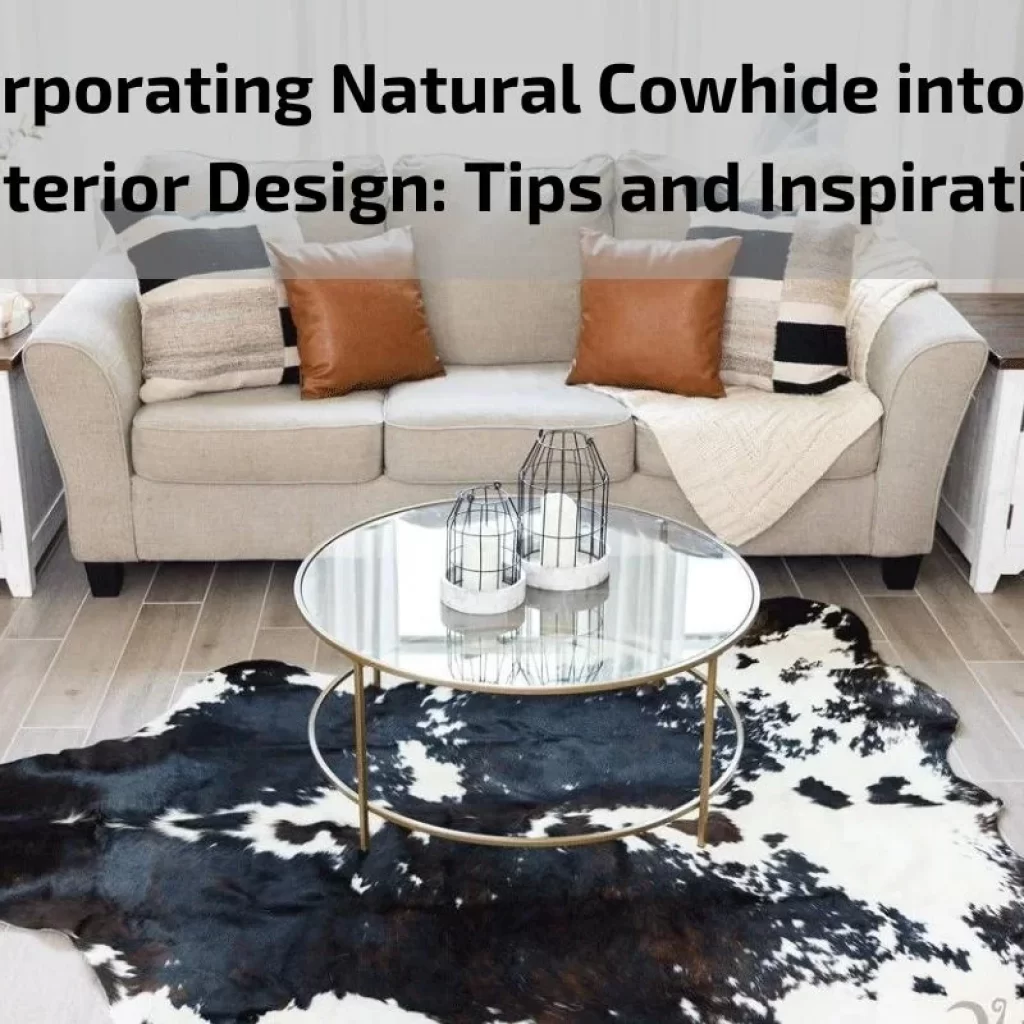Incorporating Natural Cowhide into Your Interior Design: Tips and Inspiration

In the realm of interior design, the allure of natural elements continues to captivate homeowners and designers alike. Among these elements, natural cowhide stands out as a timeless and versatile material that adds warmth, texture, and character to any space. Whether used as a statement rug, upholstery accent, or decorative piece, natural cowhide brings a sense of authenticity and rustic charm to interior environments.
In this guide, we delve into the art of incorporating natural cowhide into your interior design, offering a plethora of tips and inspiration to help you unleash the full potential of this distinctive material. From understanding the unique characteristics of cowhide to exploring creative ways to integrate it into your decor scheme, we embark on a journey that celebrates the beauty and versatility of natural cowhide.
Definition and brief overview of natural cowhide
Natural cowhide refers to the untreated skin and hair of a cow that has been preserved through a tanning process. It is a byproduct of the meat industry and is sourced from cattle raised for their meat and dairy production. Natural cowhide retains the distinctive markings, textures, and colors of the animal it comes from, making each piece unique in its appearance.
In its natural state, cowhide is rich in texture, with variations in hair length, thickness, and color patterns. The hide may feature markings such as spots, stripes, or patches, adding to its rustic charm and authenticity. Natural cowhide is prized for its durability, versatility, and aesthetic appeal, making it a popular choice for various home decor applications.
The tanning process involved in preparing natural cowhide involves treating the raw hide with chemicals to prevent decomposition and to stabilize the material for long-term use. However, unlike dyed or processed hides, natural cowhide retains its original color and texture, offering a genuine and authentic look that complements a variety of interior design styles.
Natural cowhide rugs, throws, pillows, and upholstery are commonly used to add warmth, texture, and visual interest to living spaces, whether in modern, rustic, or eclectic interiors. The inherent beauty and durability of natural cowhide make it a timeless and versatile choice for enhancing the ambiance of homes, offices, and commercial settings alike.
Importance of Natural Cowhide in Interior Design and Home Decor
Natural cowhide holds significant importance in interior design and home decor for several compelling reasons:
Authenticity and Character: Natural cowhide brings a sense of authenticity and character to interior spaces. Its unique markings, textures, and color variations reflect the individuality of each hide and add a touch of rustic charm to any room.
Versatility: Natural cowhide is incredibly versatile and can be used in a variety of ways in interior design. Whether as a statement rug in the living room, a cozy throw on a sofa, or as upholstery for chairs and ottomans, cowhide adds warmth and visual interest to any space.
Texture and Dimension: Cowhide rugs and accessories introduce texture and dimension to interior settings, creating depth and visual appeal. The natural variations in hair length and texture create a tactile experience that enhances the sensory richness of the environment.
Durability and Longevity: Natural cowhide is known for its durability and resilience, making it a practical choice for high-traffic areas in the home. Unlike synthetic materials, cowhide is resistant to wear and tear and can withstand the rigors of daily use, ensuring longevity and value over time.
Timeless Elegance: Natural cowhide exudes a timeless elegance that transcends trends and fads. Its classic appeal makes it a versatile design element that can seamlessly integrate into a variety of decor styles, from traditional to contemporary.
Sustainable and Eco-Friendly: As a byproduct of the meat industry, natural cowhide is a sustainable and eco-friendly material choice for interior design. Utilizing cowhide in home decor helps minimize waste and repurpose resources, making it an environmentally conscious option for conscientious consumers.
Hypoallergenic Properties: Natural cowhide is inherently hypoallergenic, making it suitable for individuals with allergies or sensitivities to synthetic materials. Its natural fibers are less likely to trap dust, dander, and allergens, creating a healthier indoor environment.
In summary, the importance of natural cowhide in interior design and home decor lies in its ability to infuse spaces with authenticity, warmth, and visual interest. From its versatile applications to its durability and sustainability, cowhide remains a cherished design element that adds both style and substance to the modern home.

Benefits of Natural Cowhide
Natural cowhide offers a plethora of benefits that make it a sought-after choice for interior design and home decor:
A. Durability and Longevity:
Natural cowhide is renowned for its exceptional durability, able to withstand heavy foot traffic and everyday use.
With proper care and maintenance, cowhide rugs and accessories can last for many years, retaining their beauty and functionality.
B. Unique Aesthetic Appeal:
Each natural cowhide is inherently unique, featuring distinctive markings, patterns, and color variations.
The natural beauty of cowhide adds visual interest and texture to any space, enhancing the overall ambiance and decor scheme.
C. Versatility in Design:
Natural cowhide rugs and accessories are incredibly versatile, suitable for a wide range of interior design styles.
Whether used as a focal point in a minimalist setting or as a rustic accent in a farmhouse-inspired space, cowhide complements various aesthetics with ease.
D. Hypoallergenic Properties:
Natural cowhide is hypoallergenic, making it an ideal choice for individuals with allergies or sensitivities to synthetic materials.
The absence of harsh chemicals and synthetic fibers reduces the risk of allergic reactions, creating a healthier indoor environment.
E. Thermal Insulation:
Cowhide rugs provide natural thermal insulation, helping to regulate room temperature and reduce energy costs.
The dense fibers of cowhide rugs trap air, providing warmth and comfort underfoot during colder months.
F. Easy Maintenance:
Natural cowhide is relatively low-maintenance and easy to clean.
Regular vacuuming and occasional shaking or airing out are usually sufficient to keep cowhide rugs and accessories looking fresh and vibrant.
G. Sustainable and Eco-Friendly:
As a byproduct of the meat industry, natural cowhide promotes sustainability and reduces waste.
By repurposing cowhide into rugs and accessories, consumers contribute to the responsible use of resources and minimize environmental impact.
In summary, the benefits of natural cowhide extend beyond aesthetics, encompassing durability, versatility, hypoallergenic properties, and sustainability. As a timeless design element, natural cowhide enhances the beauty and functionality of interior spaces while embodying the rustic elegance of nature.
Choosing the Right Size and Shape of Natural Cowhide Rug for Your Space
Selecting the appropriate size and shape of a natural cowhide rug is crucial to achieving a balanced and harmonious look in your space. Consider the following factors when choosing the perfect cowhide rug for your room:
Room Size and Layout:
Measure the dimensions of your room to determine the available floor space for the rug.
Consider the layout of furniture and the flow of foot traffic within the room when selecting the size and shape of the rug.
Placement and Purpose:
Determine the primary purpose of the cowhide rug. Is it intended to anchor a seating area, define a focal point, or add warmth to a bare floor?
Choose a rug size and shape that complements the intended placement and function of the space.
Proportions and Scale:
Ensure that the size of the cowhide rug is proportionate to the scale of the room and the furniture within it.
A rug that is too small may get lost in a large room, while one that is too large can overwhelm a smaller space.
Consideration of Furniture Placement:
For a living room or sitting area, select a cowhide rug that allows all key pieces of furniture, such as sofas and chairs, to rest partially on the rug.
Leave a border of floor space around the edges of the rug to create a balanced and visually appealing arrangement.
Shape and Style:
Natural cowhide rugs are available in various shapes, including rectangular, square, round, and irregular shapes.
Choose a shape that complements the overall design aesthetic of your space and enhances its visual appeal.
Layering and Styling:
Consider layering the cowhide rug with other rugs or floor coverings to add depth and texture to the room.
Experiment with different orientations and angles to find the most visually pleasing arrangement for your space.
Personal Preference and Comfort:
Ultimately, trust your instincts and personal preferences when selecting a cowhide rug for your space.
Choose a rug size and shape that not only fits the practical requirements of the room but also reflects your individual style and enhances your comfort and enjoyment of the space.
By carefully considering these factors, you can confidently choose the right size and shape of a natural cowhide rug that enhances the beauty and functionality of your space while adding warmth and personality to your home decor.

Maintenance and Care Natural Cowhide Rugs
Proper maintenance and care are essential to preserve the beauty and longevity of natural cowhide rugs. Follow these tips to keep your cowhide rug looking its best:
Regular Vacuuming:
Use a vacuum cleaner with a soft brush attachment to remove loose dirt, dust, and debris from the surface of the cowhide rug.
Vacuum in the direction of the hair or grain to prevent damage to the hide fibers.
Shake Out and Air:
Periodically take the cowhide rug outside and shake it vigorously to dislodge any embedded dirt or particles.
Hang the rug over a railing or clothesline and allow it to air out in the fresh air and sunlight for a few hours to refresh and revitalize the hide fibers.
Spot Cleaning:
Immediately attend to spills and stains by blotting them with a clean, damp cloth or sponge.
Avoid rubbing the stain vigorously, as this can spread it further and damage the hide.
Use a mild soap or leather cleaner specifically formulated for cowhide rugs, and follow the manufacturer’s instructions carefully.
Avoid Moisture and Humidity:
Keep natural cowhide rugs away from areas of high moisture and humidity, such as bathrooms and kitchens.
Avoid placing potted plants or other sources of moisture directly on the rug, as prolonged exposure to moisture can lead to mold and mildew growth.
Rotate and Move:
Rotate the cowhide rug periodically to ensure even wear and sun exposure.
Avoid placing heavy furniture or sharp objects on the rug for extended periods, as this can cause indentations or damage to the hide fibers.
Professional Cleaning:
For deep cleaning or stubborn stains, consider hiring a professional leather cleaner or rug cleaning service.
Professional cleaners have the expertise and equipment to effectively treat and rejuvenate natural cowhide rugs without causing damage.
Storage:
If storing the cowhide rug for an extended period, clean and dry the rug thoroughly before folding or rolling it for storage.
Store the rug in a cool, dry place away from direct sunlight and moisture, and avoid folding or creasing the rug to prevent permanent damage to the hide fibers.
By following these maintenance and care tips, you can prolong the life and beauty of your natural cowhide rug, ensuring that it remains a cherished accent piece in your home for years to come.
Conclusion
In conclusion, natural cowhide rugs stand as timeless and versatile additions to any home décor scheme. Their unique texture, natural beauty, and durability make them prized possessions that add warmth, character, and visual interest to interior spaces.


0 comments